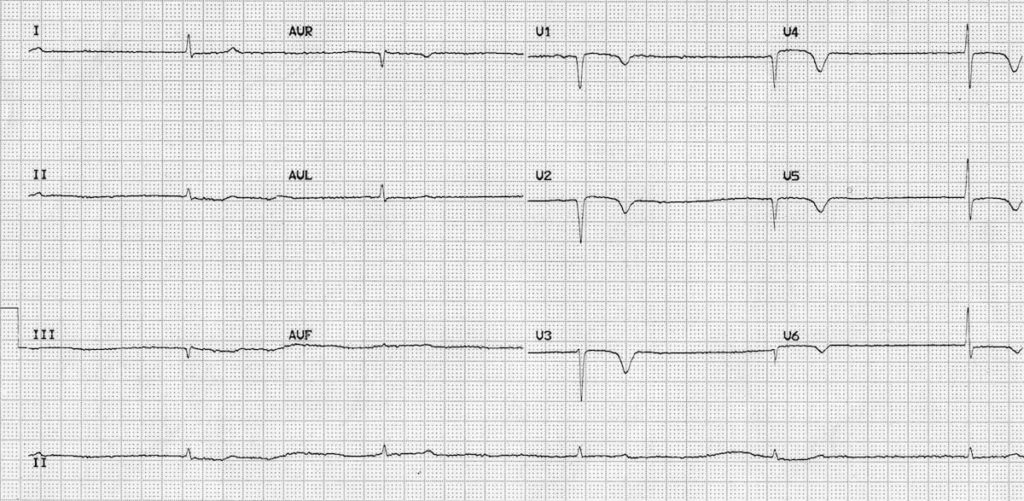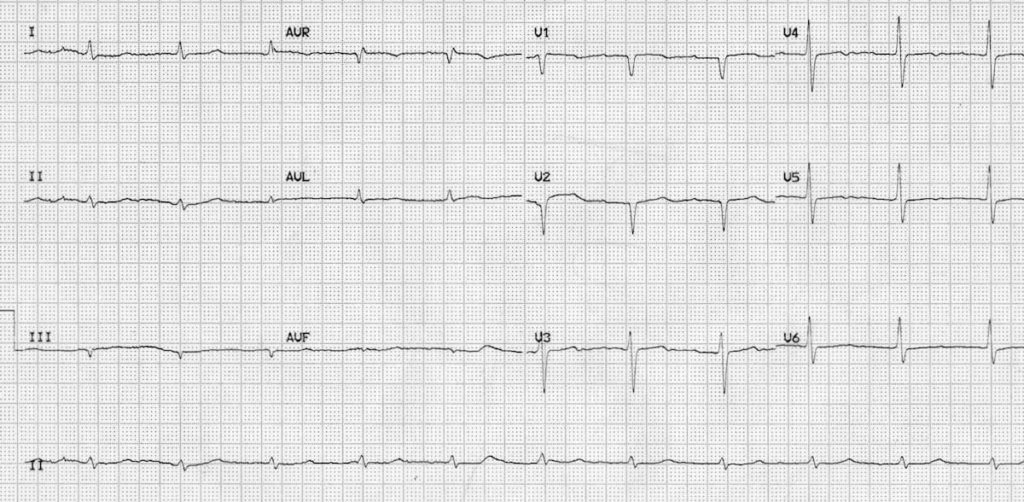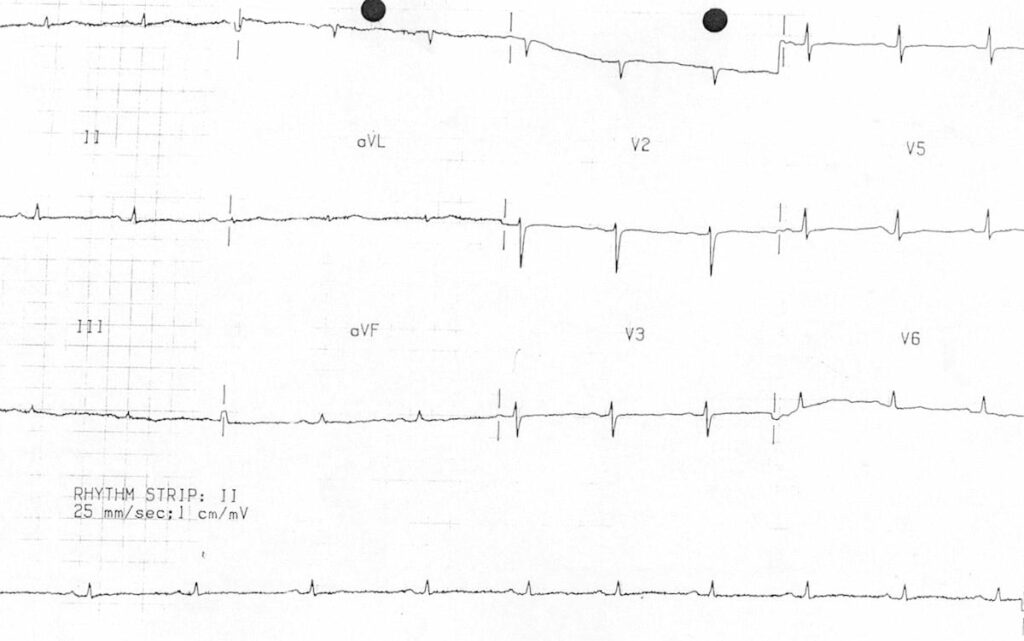Hypothyroidism
ECG abnormalities associated with Hypothyroidism
Severe hypothyroidism (myxoedema) causes a triad of:
- Bradycardia
- Low QRS voltage
- Widespread T-wave inversions (usually without ST deviation)
Other ECG changes that may be seen include:
Mechanism
ECG changes may be secondary to:
- Myxoedematous deposits of gelatinous connective tissue within the myocardium.
- Decreased activity of the sympathetic nervous system
- Effects on the myocardium of reduced levels of thyroxine (i.e. reduced inotropy/chronotropy)
ECG Examples
Example 1a

Myxoedema coma
- This is the admission ECG of a 79-year old man who was referred to ICU with coma, hypothermia, severe bradycardia and hypotension refractory to inotropes.
- TSH was markedly elevated with an undetectable T4.
- The ECG shows marked bradycardia (30 bpm) with low QRS voltages (esp. in the limb leads) and widespread T-wave inversions, typical of severe myxoedema.
Example 1b

Myxoedema coma (after treatment)
- An ECG of the same patient shortly after initiation of thyroid replacement with intravenous T3 and T4.
- The heart rate has normalised and the T-wave inversion has corrected.
- Low voltage in the limb leads persists and is likely due to myxoedematous infiltration of the myocardium.
Example 2

Myxoedema
- Example of low QRS voltage due to myxoedema.
Related Topics
Advanced Reading
Online
- Wiesbauer F, Kühn P. ECG Mastery: Yellow Belt online course. Understand ECG basics. Medmastery
- Wiesbauer F, Kühn P. ECG Mastery: Blue Belt online course: Become an ECG expert. Medmastery
- Kühn P, Houghton A. ECG Mastery: Black Belt Workshop. Advanced ECG interpretation. Medmastery
- Rawshani A. Clinical ECG Interpretation ECG Waves
- Smith SW. Dr Smith’s ECG blog.
- Wiesbauer F. Little Black Book of ECG Secrets. Medmastery PDF
Textbooks
- Zimmerman FH. ECG Core Curriculum. 2023
- Mattu A, Berberian J, Brady WJ. Emergency ECGs: Case-Based Review and Interpretations, 2022
- Straus DG, Schocken DD. Marriott’s Practical Electrocardiography 13e, 2021
- Brady WJ, Lipinski MJ et al. Electrocardiogram in Clinical Medicine. 1e, 2020
- Mattu A, Tabas JA, Brady WJ. Electrocardiography in Emergency, Acute, and Critical Care. 2e, 2019
- Hampton J, Adlam D. The ECG Made Practical 7e, 2019
- Kühn P, Lang C, Wiesbauer F. ECG Mastery: The Simplest Way to Learn the ECG. 2015
- Grauer K. ECG Pocket Brain (Expanded) 6e, 2014
- Surawicz B, Knilans T. Chou’s Electrocardiography in Clinical Practice: Adult and Pediatric 6e, 2008
- Chan TC. ECG in Emergency Medicine and Acute Care 1e, 2004
LITFL Further Reading
- ECG Library Basics – Waves, Intervals, Segments and Clinical Interpretation
- ECG A to Z by diagnosis – ECG interpretation in clinical context
- ECG Exigency and Cardiovascular Curveball – ECG Clinical Cases
- 100 ECG Quiz – Self-assessment tool for examination practice
- ECG Reference SITES and BOOKS – the best of the rest
ECG LIBRARY
Emergency Physician in Prehospital and Retrieval Medicine in Sydney, Australia. He has a passion for ECG interpretation and medical education | ECG Library |
MBBS DDU (Emergency) CCPU. Adult/Paediatric Emergency Medicine Advanced Trainee in Melbourne, Australia. Special interests in diagnostic and procedural ultrasound, medical education, and ECG interpretation. Co-creator of the LITFL ECG Library. Twitter: @rob_buttner

